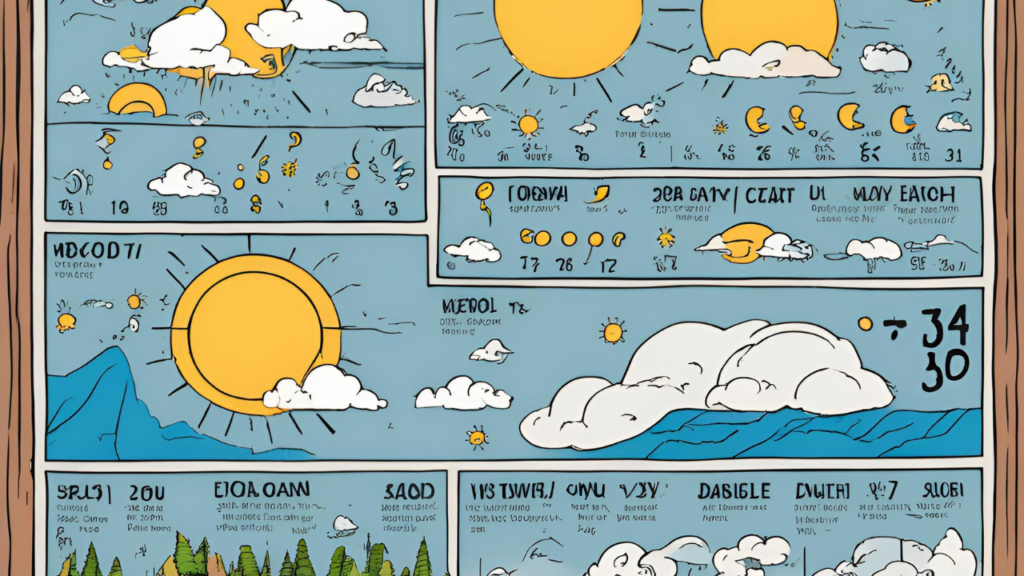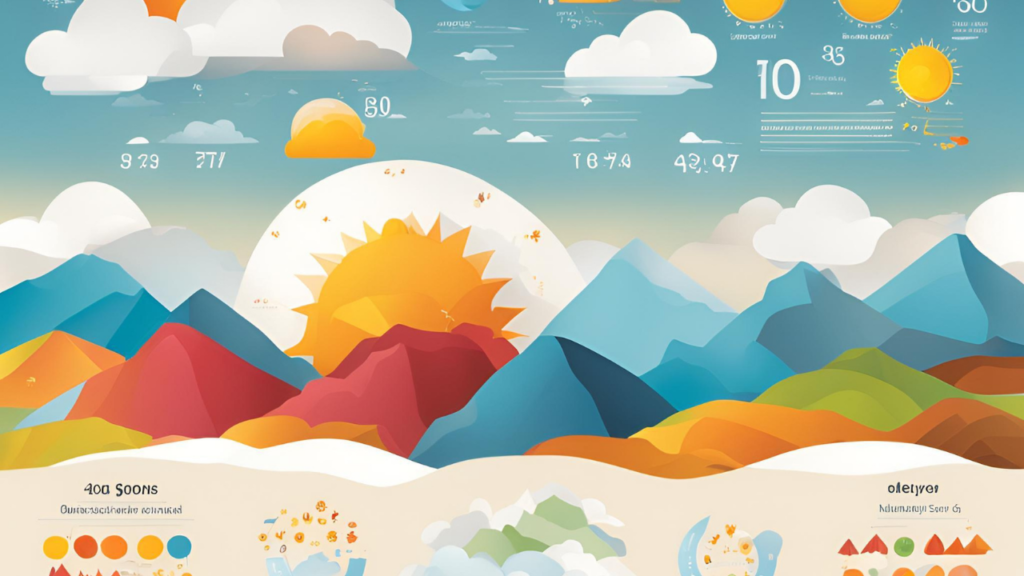Introduction of Delhi Weather
Delhi, the capital city of India, experiences extreme weather conditions throughout the year. The climate here is classified as humid subtropical, with scorching summers, unpredictable monsoons, and chilling winters.
Understanding Delhi’s weather is essential for both residents and visitors to prepare for sudden temperature changes, pollution levels, and seasonal variations. This guide will provide a detailed seasonal breakdown, including forecasts, travel tips, and FAQs.
Let’s dive into Delhi’s weather conditions, best times to visit, and seasonal challenges.
🌍 Delhi’s Weather Overview (Annual Climate Chart)
| Season | Duration | Temperature Range | Key Features |
|---|---|---|---|
| Summer ☀️ | March – June | 30°C – 48°C | Intense heat, hot dry winds (loo) |
| Monsoon 🌧️ | July – September | 25°C – 35°C | Heavy rainfall, high humidity |
| Autumn 🍂 | October – November | 15°C – 30°C | Pleasant weather, festive season |
| Winter ❄️ | December – February | 2°C – 20°C | Cold waves, fog, high pollution |
Delhi’s climate is heavily influenced by Himalayan winds from the north and desert air from Rajasthan, making the weather patterns quite unpredictable.
Delhi, the bustling capital of India, is known for its unique and diverse climate. From scorching summers to chilly winters, the city experiences a wide range of temperatures throughout the year. Whether you’re planning a visit to Delhi or simply curious about its climate, this article will give you an in-depth understanding of the weather in the city.

🔥 Delhi Summers (March – June) – The Hottest Season
Delhi’s summers are extremely hot and dry, making it one of the warmest cities in India. The season starts in March and continues till June, with temperatures soaring up to 48°C in some areas.
☀️ Weather Characteristics:
- Scorching heat & high temperatures (Average: 30°C – 45°C, extreme: 48°C).
- “Loo” (hot dry winds) cause dehydration and heat strokes.
- Humidity levels remain low, making the heat even more unbearable.
- Dry, dusty air can cause respiratory issues.
🚨 Common Challenges:
✅ Extreme heat can cause sunburn and dehydration.
✅ Power cuts are frequent due to increased demand for electricity.
✅ Water shortages occur in some parts of the city.
✅ Tips to Survive Delhi’s Summer:
✔️ Stay Hydrated – Drink at least 3-4 liters of water daily.
✔️ Avoid Direct Sunlight – Wear hats, sunglasses, and sunscreen.
✔️ Use Light Cotton Clothes – Avoid synthetic fabrics.
✔️ Plan Indoor Activities – Avoid stepping out during 12 PM – 4 PM.
💡 Fun Fact:
Did you know that during extreme summers, road tar in Delhi melts due to heat?
🌧️ Delhi Monsoons (July – September) – Rain Brings Relief
Monsoons arrive in Delhi by late June or early July, bringing much-needed relief from the summer heat. However, monsoons in Delhi are unpredictable, ranging from light drizzles to heavy downpours causing floods.
🌦️ Weather Characteristics:
- Moderate to heavy rainfall (Average: 25°C – 35°C).
- Increased humidity (up to 80%), making it uncomfortable.
- Sudden rainstorms cause waterlogging and traffic congestion.
- Occasional thunderstorms and strong winds.
🚨 Common Challenges:
✅ Waterlogging in low-lying areas like ITO, Minto Road, and RK Puram.
✅ Traffic Jams due to flooded streets.
✅ Rise in Mosquito-Borne Diseases like dengue and malaria.
✅ Tips to Stay Safe in Monsoons:
✔️ Always Carry an Umbrella – Sudden showers are common.
✔️ Avoid Waterlogged Areas – Roads may become slippery.
✔️ Drink Boiled Water – Prevents waterborne diseases.
✔️ Check Weather Forecast Before Traveling.
💡 Fun Fact:
Delhi’s rain pattern is unpredictable. Sometimes, it rains heavily in South Delhi, while North Delhi remains dry!
❄️ Delhi Winters (December – February) – Freezing Cold & Foggy Days
Winters in Delhi are harsh and freezing, with dense fog and low visibility affecting daily life. The coldest months are December and January, with temperatures dropping to as low as 2°C.
❄️ Weather Characteristics:
- Chilly mornings and evenings (Average: 2°C – 20°C).
- Cold waves from the Himalayas bring a sharp temperature drop.
- Dense fog reduces visibility, affecting flights and trains.
- Smog and air pollution worsen due to temperature inversion.
🚨 Common Challenges:
✅ Fog causes major flight and train delays.
✅ High air pollution levels (AQI above 400) impact health.
✅ Cold waves can cause hypothermia if not dressed properly.
✅ Tips to Stay Warm & Safe in Winters:
✔️ Wear Multiple Layers – Use woolen sweaters, jackets, and thermals.
✔️ Use Room Heaters – Keep indoor temperatures comfortable.
✔️ Avoid Early Morning Travel – Poor visibility makes driving risky.
✔️ Wear an N95 Mask – Protect yourself from pollution.
💡 Fun Fact:
The famous Bollywood song “Dilli Ki Sardi” perfectly describes Delhi’s winter chills!

🗓️ Best Time to Visit Delhi
The best time to visit Delhi is from October to March when the weather is pleasant and ideal for sightseeing.
🌟 Why Visit Delhi During This Time?
✔️ October-November: Pleasant autumn weather and Diwali celebrations.
✔️ December-January: Experience Delhi’s winter charm and food festivals.
✔️ February-March: Spring season with clear skies and flower bloom.
⚠️ Delhi’s Air Pollution & Weather Impact
Delhi often faces severe air pollution, especially during October to January. The Air Quality Index (AQI) often crosses 500+, which is classified as hazardous.
🚨 Causes of Pollution in Delhi:
❌ Vehicular emissions from cars and buses.
❌ Crop burning (stubble burning) in nearby states.
❌ Industrial emissions and construction dust.
✅ How to Stay Safe from Air Pollution?
✔️ Wear an N95 mask when stepping outside.
✔️ Use air purifiers at home.
✔️ Avoid morning walks on high-pollution days.
Additional Features of Delhi Weather
1. Diurnal Temperature Variation
One unique feature of Delhi’s climate, especially during the transition periods of spring and autumn, is its significant diurnal temperature variation. This refers to the drastic difference between day and night temperatures.
- Day and Night Difference: During the summer and winter months, Delhi can experience temperature differences of up to 10°C to 15°C between day and night. For example, while daytime temperatures in winter may reach 20°C, nighttime temperatures can dip to 5°C or below. This variation is especially noticeable in the months of December and January.
- Impact on Comfort: It’s essential to dress in layers to accommodate the temperature fluctuations, as mornings and evenings can be much cooler than midday.
2. Urban Heat Island Effect
Delhi, like many large cities, suffers from the Urban Heat Island (UHI) effect. This phenomenon occurs when urban areas experience higher temperatures than their rural surroundings due to human activities.
- Cause of UHI: Factors like concrete buildings, asphalt roads, and the large number of vehicles contribute to the heat retention in the city.
- Impact: During the summer months, this effect amplifies the already high temperatures in the city, making it even hotter than surrounding rural areas. This leads to an increase in energy consumption, poor air quality, and health risks like heat strokes.
3. Dust and Air Quality in Summer
Apart from the usual heat, Delhi summers are marked by dust storms and poor air quality. The arid conditions, combined with local dust storms, create an additional challenge for residents and travelers.
- Dust Storms: These storms are frequent in the months of May and June. They can reduce visibility and cause discomfort, with dust particles settling on everything.
- Air Pollution: As Delhi is a major urban hub with a high number of vehicles, industrial emissions, and construction activities, the air quality deteriorates in summer. Poor air quality leads to increased respiratory issues.
4. Fog and Low Visibility in Winter
In the winter months, fog becomes a significant feature of Delhi’s weather. It is particularly prevalent in December and January.
- Morning Fog: The city is often blanketed with thick fog during the early mornings, which can last until late afternoon. This fog significantly reduces visibility and can delay travel and commuting, especially for flights and trains.
- Air Pollution and Smog: In addition to fog, Delhi also faces smog during winter, which is a combination of fog and air pollution. The presence of high pollution levels in the air exacerbates the visibility issues, making it hazardous for people with respiratory conditions.
5. Thunderstorms and Hailstorms
Delhi experiences thunderstorms and, occasionally, hailstorms during the monsoon and pre-monsoon months.
- Thunderstorms: Thunderstorms in Delhi are intense and often come with heavy rainfall, strong winds, and lightning. These storms can be unpredictable and may cause temporary power outages and disruption to outdoor activities.
- Hailstorms: In rare instances, the city faces hailstorms during the pre-monsoon or monsoon seasons. These storms can cause damage to crops, vehicles, and infrastructure. They typically occur when there is a sudden shift in weather patterns.
6. Microclimates within the City
Delhi has various microclimates due to its vast size and diverse geographical features. Some areas experience slightly different weather patterns compared to others.
- Central Delhi vs. Outer Areas: Central Delhi, which has a high density of buildings and infrastructure, experiences higher temperatures than the outer regions like Dwarka, Rohini, or Greater Noida, which are more suburban in nature.
- Hills and Gardens: Areas near gardens, parks, and hills like the Aravalli Range tend to have slightly cooler temperatures due to the greenery and elevation. These areas offer a welcome respite from the heat, especially during summers.
7. Seasonal Dust and Airborne Allergens
Delhi’s weather also brings a high concentration of seasonal dust and airborne allergens, particularly during the spring and autumn months. The dry conditions stir up dust, while pollen levels tend to rise in certain seasons.
- Allergy Alert: People with respiratory issues or allergies may feel discomfort due to airborne pollutants, dust, and pollen.
- Mitigation: Wearing a mask or staying indoors during high-pollution periods can help mitigate these effects.
8. Role of Local Winds
Delhi is influenced by seasonal winds, which play a significant role in its weather patterns.
- Loo Winds in Summer: The “loo” is a strong, dry, hot wind that blows from the west and northwest of India during the summer. These winds can raise temperatures dramatically and contribute to the extreme heat in Delhi.
- Monsoon Winds: During the monsoon season, the southwest monsoon winds bring heavy rains. These winds help in reducing temperatures but also increase humidity levels.
9. Climate Change Impact
Delhi, like many other parts of the world, is witnessing the impact of climate change. Over the years, the city has experienced:
- Rising Temperatures: There has been an increase in average temperatures, especially during the summer months. This trend is a result of global warming and urbanization.
- Erratic Weather Patterns: The weather in Delhi has become more unpredictable, with shorter rainy seasons and increasingly intense heatwaves.
10. Agriculture and Air Quality
The seasonal burning of crop residue in neighboring states like Punjab and Haryana contributes to the city’s air pollution, especially in winter. The burning of stubble releases massive amounts of smoke and particulate matter into the atmosphere, worsening Delhi’s already poor air quality.
- Stubble Burning Impact: During October-November, the wind carries this smoke into Delhi, making the air unhealthy and triggering smog. This phenomenon, combined with colder temperatures and fog, makes it one of the most challenging times for respiratory health in the city.

❓ Frequently Asked Questions (FAQs)
Q1: What is the coldest month in Delhi?
👉 January, when temperatures drop to 2-3°C.
Q2: When does summer end in Delhi?
👉 By late June, when the monsoon season begins.
Q3: Why is Delhi’s weather unpredictable?
👉 Due to its location near the Himalayas and Thar Desert, which affect temperature and winds.
Q4: When is pollution the worst in Delhi?
👉 From October to January, when smog levels peak due to stubble burning and winter fog.
Conclusion
Delhi’s weather is extreme and diverse, with scorching summers, rainy monsoons, and freezing winters. Planning and staying updated with weather forecasts can help you enjoy the city comfortably.
For daily weather updates, bookmark Yojanaji.com and stay informed! 🚀

Tamim is a distinguished policy analyst with over 15 years of experience in analyzing, government schemes and policies. Tamim brings a wealth of knowledge and expertise in the field of social development.
